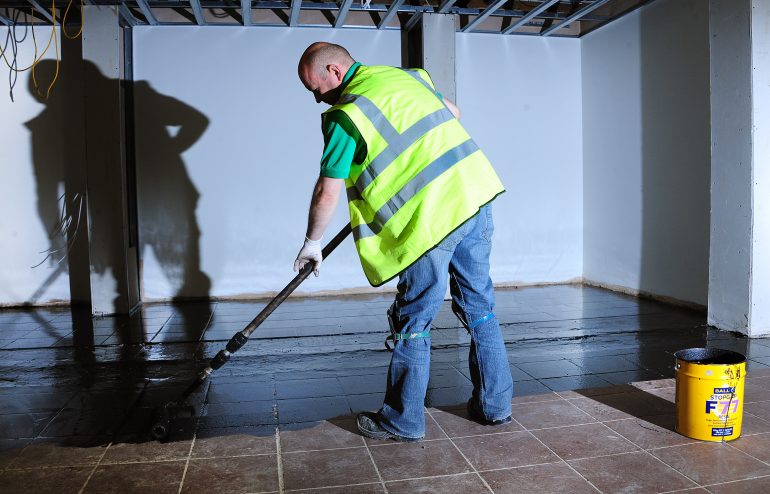Q. What adhesive should I use for bonding rubber floorcoverings?
A. The first choice would be an adhesive that has been specially designed for installing rubber floorcoverings, such as F. Ball’s Styccobond F58. It has a high film strength to provide good dimensional stability and prevent rubber floorcoverings from moving when subject to heavy traffic. It also offers high initial grab to make the installation process easier. Alternatively, F. Ball’s Styccobond F44 acrylic adhesive is also suitable for installing some rubber floorcoverings owing to the high bond strength and high initial tack it offers. You can check floorcovering-adhesive compatibility by consulting F. Ball’s Recommended Adhesives Guide (RAG), which lists adhesives recommended for use with over 6,000 floorcoverings produced by over 200 manufacturers. It’s available as a free app or a printed booklet, and an interactive version can also be found on the F. Ball website.
Q. I’d like to create a wearing surface that has a rough finish outdoors. What should I use?
A. You can apply a layer of Stopgap 850 Exterior, F. Ball’s weather-resistant levelling compound for outdoor use. Once it is dry enough to be walked on (between 90 minutes and four hours depending on temperature) you can create a scratch coat by mixing 25kg of Stopgap 850 with 4.25 litres of clean water, pouring the material onto the surface and spreading it thinly using a steel trowel to leave a textured finish.
Q. Can I use Stycco Flex to adhere brass trims to stone staircases?
A. Yes. Stycco Flex, F. Ball’s flexible tube adhesive, can be used to bond almost any two materials together, including two impervious surfaces. The high strength build-up and fast curing time provided by the product means it can secure stair nosings and trims, without the need for mechanical fixings, in as little as 60 minutes.
Q. I’m installing LVTs as part of a refurb in a care home where carpet is currently installed. What procedures should I follow?
A. Lift up the old carpet and underlay, leaving only well-bonded adhesive residues behind. To create a perfectly level base for the installation of floorcoverings, apply F. Ball’s Stopgap 1200 Pro levelling compound directly on top of the old adhesive residues. Stopgap 1200 Pro can be applied directly over old adhesive residues. When used in this way, there’s no need to prime the surface beforehand, saving further time. Then use Styccobond F46 pressure sensitive adhesive to install LVTs. Styccobond F46 dries to a permanent tack and provides a high bond strength, which increases as it is trafficked, and strong initial tack – an advantage when positioning intricate designs and patterns.
Q. When conducting a subfloor moisture test using a digital hygrometer, I’ve been given a reading of 95%. What does this mean?
A. The percentage is a measure of relative humidity (RH) at the upper surface of the subfloor. Subfloor relative humidity levels above 75% (65% if wood floorcoverings are to be installed) will compromise the final flooring installation without the use of a moisture management solution. The application of a waterproof surface membrane will help prevent excess subfloor moisture damaging floorcoverings by controlling the passage of moisture. A moisture test reading of 95% RH indicates a very damp subfloor, so it is recommended that you apply Stopgap F77, a two-part, solvent free epoxy resin system that will isolate residual construction moisture and rising damp where relative humidity values are up to 98%.
Q. I want to install LVTs over ceramic tiles. What primer and levelling compound should I use?
A. Stopgap P141 is a specially formulated primer designed to promote adhesion of subsequently applied levelling compounds when use over non-absorbent subfloors, such as ceramic tiles.It’s contains recycled uPVC pulver to create a textured finish and enhance bond performance between subfloor and levelling compound. Levelling compound selection should be determined by what the area will be used for and the timescale in which the project needs to be completed. Fast track levelling compounds, such as F. Ball’s Fast Track 30, are walk-on hard from 30 minutes, and will be ready to receive floorcoverings in as little as 30 minutes following application. Heavy-duty levelling compounds, such as F. Ball’s Stopgap 300 HD, are ideal for where floors will be subject to high foot traffic and heavy loads. The excellent self-levelling properties of Stopgap 300 HD helps ensure a perfectly smooth and even base for the installation of LVTs.
Our technical team are on standby to answer questions about your projects and F. Ball products from 8.30am – 5.00pm, Monday to Friday.
Please note: site conditions vary. Don’t rely on these specific responses for your own project. If you are unsure about any technical issue relating to specific flooring installations, contact the F. Ball Technical Service team on 01538 361633 or consult the product data sheets available from F. Ball’s website.


